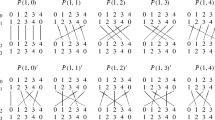Abstract
Two resolutions of the same 3-design are said to be orthogonal when each parallel class of one resolution has at most one block in common with each parallel class of the other resolution. If a Steiner quadruple system has two mutually orthogonal resolutions, the design is called doubly resolvable and denoted by DRSQS. In this paper, we define almost doubly resolvable candelabra quadruple system and then to get a recursive construction of DRSQS, i.e., for \(n\ge 16\), if there is a DRSQS(n), then there exists a DRSQS\((14n-12)\) and a DRSQS\((16n-12)\).
Similar content being viewed by others
References
Bose R.C., Shrikhande S.S., Parker E.T.: Further results on the construction of mutually orthogonal Latin squares and the falsity of Euler’s conjecture. Can. J. Math. 12, 189–203 (1960).
Booth T.R.: A resolvable quadruple system of order 20. Ars Comb. 5, 121–125 (1978).
de Vries H.L.: On orthogonal resolutions of the classical Steiner quadruple system SQS(16). Des. Codes Cryptogr. 48, 287–292 (2008).
Dinitz J.H., Stinson D.R.: Room squares and related designs. In: Dinitz J.H., Stinson D.R. (eds.) Contemporary Design Theory: A Collection of Surveys, pp. 593–631. Wiley, New York (1992).
Greenwell D.L., Lindner C.C.: Some remarks on resolvable quadruple systems. Ars Comb. 6, 215–221 (1978).
Hartman A.: Resolvable Steiner quadruple systems. Ars Comb. 9, 263–273 (1980).
Hartman A.: Tripling quadruple systems. Ars Comb. 10, 255–309 (1980).
Hartman A.: Doubly and orthogonally resolvable quadruple systems, Ars Combin., Combinatorial Mathematics, VII, Proc. Seventh Australian Conf., Lecture Notes in Math., Univ. Newcastle, Newcastle,: vol. 829. Springer, Berlin, pp. 157–164 (1979).
Hartman A.: The existence of resolvable Steiner quadruple systems. J. Comb. Theory A 44, 182–206 (1987).
Hartman A., Phelps K.T.: Steiner quadruple systems. In: Dinitz J.H., Stinson D.R. (eds.) Contemporary Design Theory, pp. 205–240. Weiley, New York (1992).
Hung S.H.Y., Mendelsohn N.S.: On howell designs. J. Comb. Theory A 16, 174–198 (1974).
Ji L.: An improvement on H design. J. Comb. Des. 17, 25–35 (2009).
Ji L.: A complete solution to existence of H designs. J. Comb. Des. 27, 75–81 (2019).
Ji L., Zhu L.: Resolvable Steiner quadruple systems for the last 23 orders. SIAM J. Discret. Math. 19, 420–432 (2005).
Lindner C.C., Rodger C.A.: Design Theory. CRC Press, Boca Raton (2009).
Meng Z.: Doubly resolvable H designs. Graphs Comb. 32, 2563–2574 (2016).
Meng Z.: Doubly resolvable Steiner quadruple systems and related designs. Des. Codes Cryptogr. 84, 325–343 (2017).
Meng Z., Du B.: Resolvable candelabra quadruple systems with three groups. J. Comb. Des. 19, 247–267 (2011).
Meng Z., Zhang B., Wu Z.: Constructions of doubly resolvable Steiner quadruple systems. Des. Codes Cryptogr. 89, 781–795 (2021).
Mills W.H.: On the existence of H designs. Congr. Numer. 79, 129–141 (1990).
Stern G., Lenz H.: Steiner triple systems with given subspaces, another proof of the Doyen-Wilson Theorem. Bull. Un. Mal. Ital. A 17, 109–114 (1980).
Zhang X., Ge G.: Existence of resolvable H-designs with group sizes 2, 3, 4 and 6. Des. Codes Cryptogr. 55, 81–101 (2010).
Zhang X., Ge G.: H-designs with the properties of resolvability or (1,2)-resolvability. Des. Codes Cryptogr. 57, 225–256 (2010).
Acknowledgements
The authors would like to thank the anonymous referees for their helpful comments and suggestions.
Author information
Authors and Affiliations
Corresponding author
Additional information
Communicated by C. J. Colbourn.
Publisher's Note
Springer Nature remains neutral with regard to jurisdictional claims in published maps and institutional affiliations.
Zhaoping Meng was supported by Shandong Provincial Natural Science Foundation Grant No. ZR2021MA057. Zhanggui Wu was supported by Education and Scientific Research Project for Young and Middle-aged Teachers of Fujian Province Grant No. JAT170685.
Rights and permissions
Springer Nature or its licensor (e.g. a society or other partner) holds exclusive rights to this article under a publishing agreement with the author(s) or other rightsholder(s); author self-archiving of the accepted manuscript version of this article is solely governed by the terms of such publishing agreement and applicable law.
About this article
Cite this article
Meng, Z., Gao, Q. & Wu, Z. A recursive construction of doubly resolvable Steiner quadruple systems. Des. Codes Cryptogr. (2024). https://doi.org/10.1007/s10623-024-01356-3
Received:
Revised:
Accepted:
Published:
DOI: https://doi.org/10.1007/s10623-024-01356-3
Keywords
- Doubly resolvable
- Steiner quadruple system
- Almost doubly resolvable candelabra quadruple system
- Group divisible t-design




